Page 9 of 289
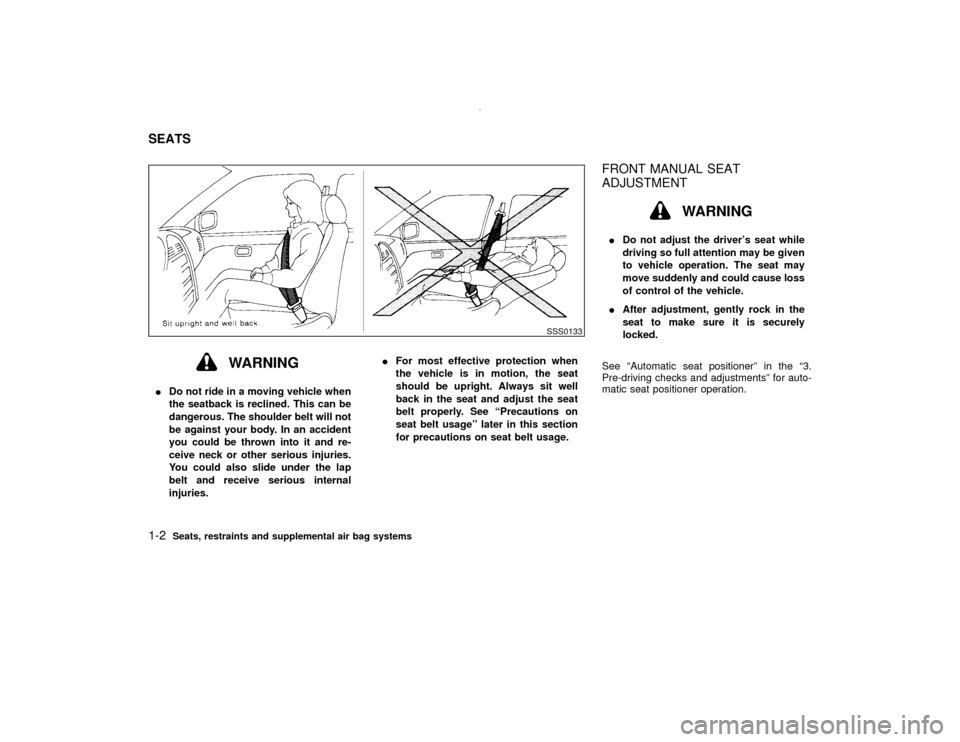
WARNING
IDo not ride in a moving vehicle when
the seatback is reclined. This can be
dangerous. The shoulder belt will not
be against your body. In an accident
you could be thrown into it and re-
ceive neck or other serious injuries.
You could also slide under the lap
belt and receive serious internal
injuries.IFor most effective protection when
the vehicle is in motion, the seat
should be upright. Always sit well
back in the seat and adjust the seat
belt properly. See ªPrecautions on
seat belt usageº later in this section
for precautions on seat belt usage.
FRONT MANUAL SEAT
ADJUSTMENT
WARNING
IDo not adjust the driver's seat while
driving so full attention may be given
to vehicle operation. The seat may
move suddenly and could cause loss
of control of the vehicle.
IAfter adjustment, gently rock in the
seat to make sure it is securely
locked.
See ªAutomatic seat positionerº in the ª3.
Pre-driving checks and adjustmentsº for auto-
matic seat positioner operation.
SSS0133
SEATS1-2
Seats, restraints and supplemental air bag systems
Z
00.1.10/R50-D/V5
X
Page 10 of 289
Forward and backwardPull the lever up while you slide the seat
forward or backward to the desired position.
Release the lever to lock the seat in position.
RecliningTo recline the seatback, pull the lever up and
lean back. To bring the seatback forward
again, pull the lever and move your body
forward. The seatback will move forward.
Seat lifter (if so equipped for driver's
seat)Turn either dial to adjust the angle and height
of the seat cushion to the desired position.
SSS0169
SSS0168
Seats, restraints and supplemental air bag systems
1-3
Z
00.1.10/R50-D/V5
X
Page 15 of 289
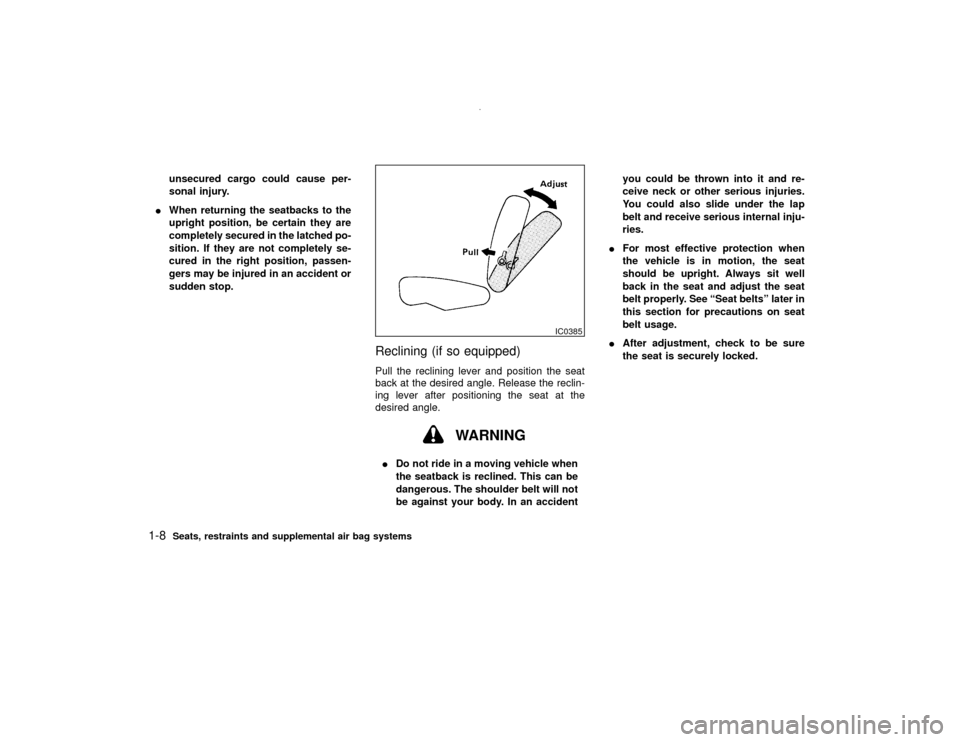
unsecured cargo could cause per-
sonal injury.
IWhen returning the seatbacks to the
upright position, be certain they are
completely secured in the latched po-
sition. If they are not completely se-
cured in the right position, passen-
gers may be injured in an accident or
sudden stop.
Reclining (if so equipped)Pull the reclining lever and position the seat
back at the desired angle. Release the reclin-
ing lever after positioning the seat at the
desired angle.
WARNING
IDo not ride in a moving vehicle when
the seatback is reclined. This can be
dangerous. The shoulder belt will not
be against your body. In an accidentyou could be thrown into it and re-
ceive neck or other serious injuries.
You could also slide under the lap
belt and receive serious internal inju-
ries.
IFor most effective protection when
the vehicle is in motion, the seat
should be upright. Always sit well
back in the seat and adjust the seat
belt properly. See ªSeat beltsº later in
this section for precautions on seat
belt usage.
IAfter adjustment, check to be sure
the seat is securely locked.
IC0385
1-8
Seats, restraints and supplemental air bag systems
Z
00.1.10/R50-D/V5
X
Page 16 of 289
HEAD RESTRAINT ADJUSTMENT
WARNING
Head restraints should be adjusted
properly as they may provide significant
protection against injury in an accident.
Do not remove them. Check the adjust-
ment after someone else uses the seat.
To raise the head restraint, just pull it up. To
lower, push the lock knob and push the head
restraint down.Adjust the head restraints so the center is level
with the center of your ears.
ARMRESTPull the armrest forward until it is horizontal.
SSS0125
SSS0178
SPA0351
Seats, restraints and supplemental air bag systems
1-9
Z
00.1.10/R50-D/V5
X
Page 28 of 289
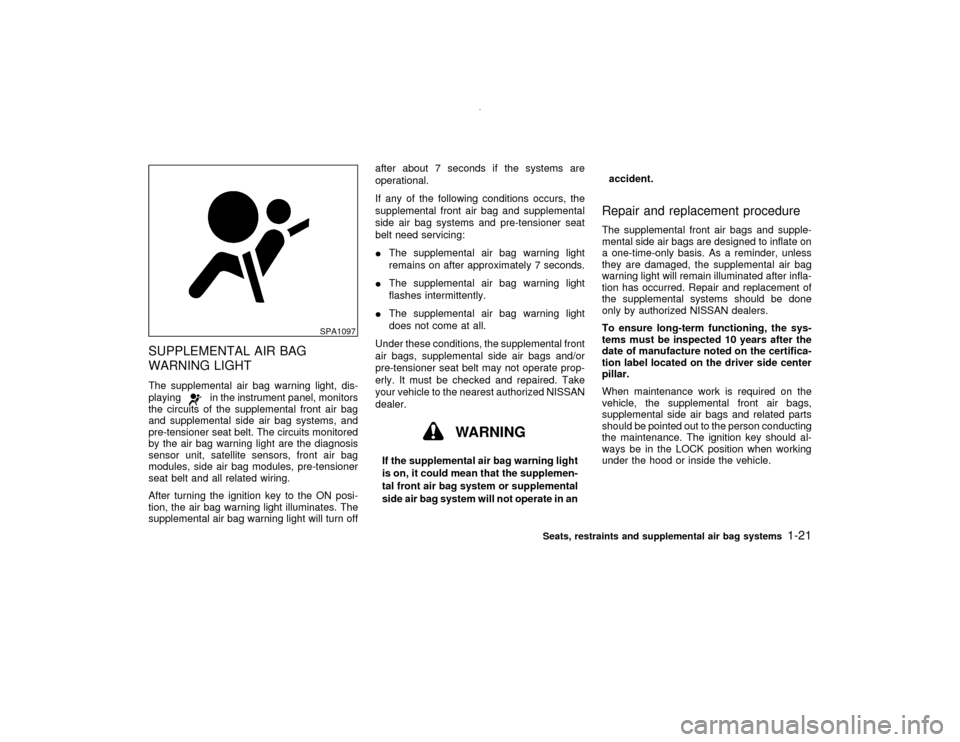
SUPPLEMENTAL AIR BAG
WARNING LIGHTThe supplemental air bag warning light, dis-
playing
in the instrument panel, monitors
the circuits of the supplemental front air bag
and supplemental side air bag systems, and
pre-tensioner seat belt. The circuits monitored
by the air bag warning light are the diagnosis
sensor unit, satellite sensors, front air bag
modules, side air bag modules, pre-tensioner
seat belt and all related wiring.
After turning the ignition key to the ON posi-
tion, the air bag warning light illuminates. The
supplemental air bag warning light will turn offafter about 7 seconds if the systems are
operational.
If any of the following conditions occurs, the
supplemental front air bag and supplemental
side air bag systems and pre-tensioner seat
belt need servicing:
IThe supplemental air bag warning light
remains on after approximately 7 seconds.
IThe supplemental air bag warning light
flashes intermittently.
IThe supplemental air bag warning light
does not come at all.
Under these conditions, the supplemental front
air bags, supplemental side air bags and/or
pre-tensioner seat belt may not operate prop-
erly. It must be checked and repaired. Take
your vehicle to the nearest authorized NISSAN
dealer.
WARNING
If the supplemental air bag warning light
is on, it could mean that the supplemen-
tal front air bag system or supplemental
side air bag system will not operate in anaccident.
Repair and replacement procedureThe supplemental front air bags and supple-
mental side air bags are designed to inflate on
a one-time-only basis. As a reminder, unless
they are damaged, the supplemental air bag
warning light will remain illuminated after infla-
tion has occurred. Repair and replacement of
the supplemental systems should be done
only by authorized NISSAN dealers.
To ensure long-term functioning, the sys-
tems must be inspected 10 years after the
date of manufacture noted on the certifica-
tion label located on the driver side center
pillar.
When maintenance work is required on the
vehicle, the supplemental front air bags,
supplemental side air bags and related parts
should be pointed out to the person conducting
the maintenance. The ignition key should al-
ways be in the LOCK position when working
under the hood or inside the vehicle.
SPA1097
Seats, restraints and supplemental air bag systems
1-21
Z
00.1.10/R50-D/V5
X
Page 33 of 289
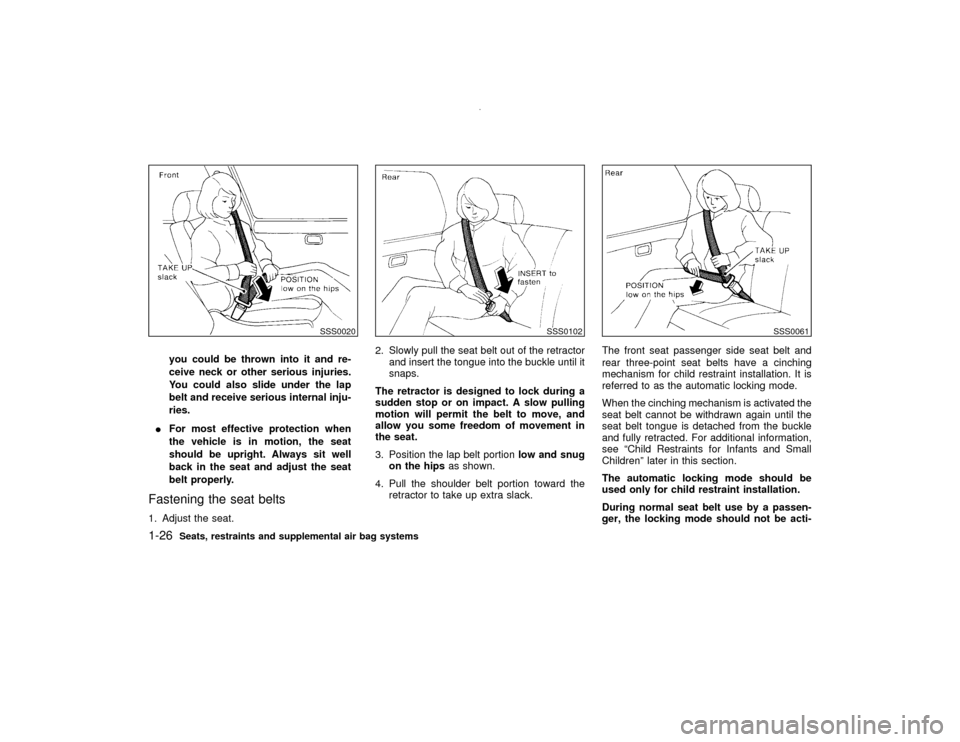
you could be thrown into it and re-
ceive neck or other serious injuries.
You could also slide under the lap
belt and receive serious internal inju-
ries.
IFor most effective protection when
the vehicle is in motion, the seat
should be upright. Always sit well
back in the seat and adjust the seat
belt properly.
Fastening the seat belts1. Adjust the seat.2. Slowly pull the seat belt out of the retractor
and insert the tongue into the buckle until it
snaps.
The retractor is designed to lock during a
sudden stop or on impact. A slow pulling
motion will permit the belt to move, and
allow you some freedom of movement in
the seat.
3. Position the lap belt portionlow and snug
on the hipsas shown.
4. Pull the shoulder belt portion toward the
retractor to take up extra slack.The front seat passenger side seat belt and
rear three-point seat belts have a cinching
mechanism for child restraint installation. It is
referred to as the automatic locking mode.
When the cinching mechanism is activated the
seat belt cannot be withdrawn again until the
seat belt tongue is detached from the buckle
and fully retracted. For additional information,
see ªChild Restraints for Infants and Small
Childrenº later in this section.
The automatic locking mode should be
used only for child restraint installation.
During normal seat belt use by a passen-
ger, the locking mode should not be acti-
SSS0020
SSS0102
SSS0061
1-26
Seats, restraints and supplemental air bag systems
Z
00.1.10/R50-D/V5
X
Page 34 of 289
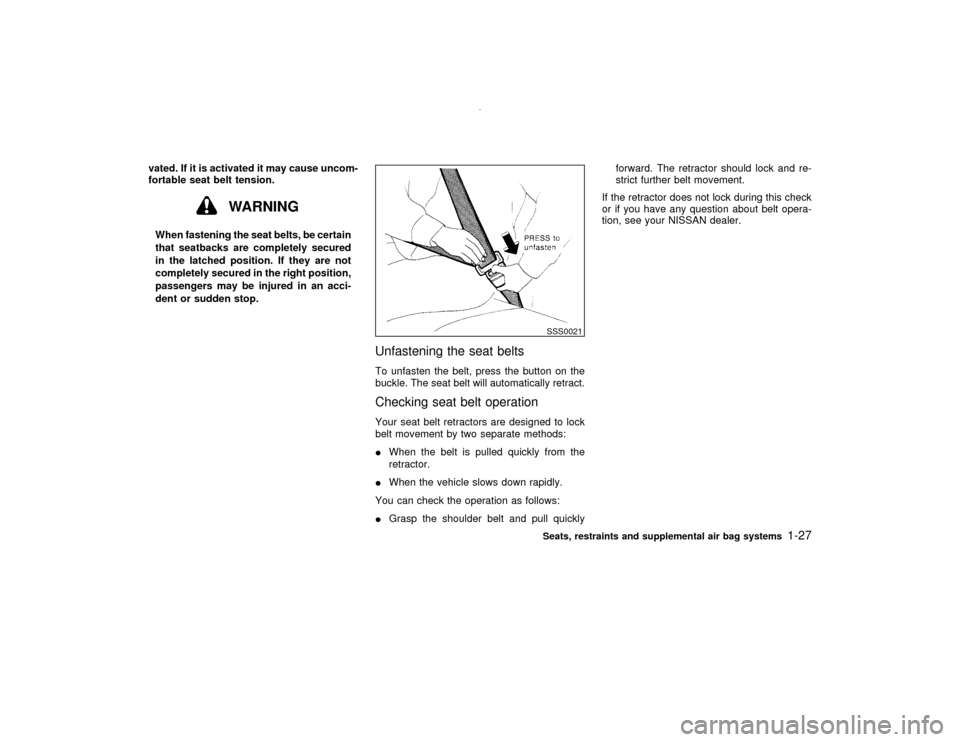
vated. If it is activated it may cause uncom-
fortable seat belt tension.
WARNING
When fastening the seat belts, be certain
that seatbacks are completely secured
in the latched position. If they are not
completely secured in the right position,
passengers may be injured in an acci-
dent or sudden stop.
Unfastening the seat beltsTo unfasten the belt, press the button on the
buckle. The seat belt will automatically retract.Checking seat belt operationYour seat belt retractors are designed to lock
belt movement by two separate methods:
IWhen the belt is pulled quickly from the
retractor.
IWhen the vehicle slows down rapidly.
You can check the operation as follows:
IGrasp the shoulder belt and pull quicklyforward. The retractor should lock and re-
strict further belt movement.
If the retractor does not lock during this check
or if you have any question about belt opera-
tion, see your NISSAN dealer.
SSS0021Seats, restraints and supplemental air bag systems
1-27
Z
00.1.10/R50-D/V5
X
Page 35 of 289
Shoulder belt height adjustment (For
front seats)The shoulder belt anchor height should be
adjusted to the position best suited for you
(see ªPrecautions on Seat Belt Usageº earlier
in this section). To adjust, push the release
buttons, then move the shoulder belt anchor to
the desired position so that the belt passes
over the shoulder. Release the adjustment
buttons to lock the shoulder belt anchor into
position.
WARNING
IAfter adjustment, release the adjust-
ment button and try to move the
shoulder belt anchor up and down to
make sure it is securely fixed in posi-
tion.
IThe shoulder belt anchor height
should be adjusted to the position
best for you. Failure to do so may
reduce the effectiveness of the entire
restraint system and increase the
chance or severity of injury in an
accident.
Seat belt hookWhen the rear seat belt is not in use, hook it at
the belt hook.
PD1328M
SPA0531
1-28
Seats, restraints and supplemental air bag systems
Z
00.1.10/R50-D/V5
X